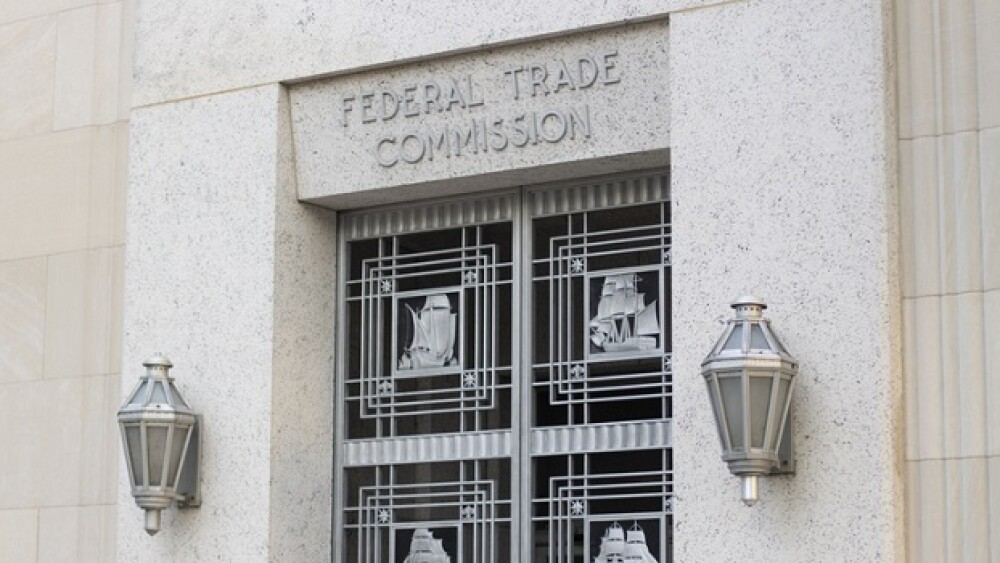Companies and patients alike are questioning the Federal Trade Commission’s challenges to various biopharma agreements.
Pictured: Sign on front of Federal Trade Commission building/iStock, hapabapa
The news earlier this week that Illumina is divesting GRAIL marked the beginning of the end for a yearslong battle over cancer testing development—and another demonstration of the Federal Trade Commission’s increased scrutiny around potential antitrust violations. Just last week, another FTC challenge made headlines when Sanofi dropped a planned licensing agreement with California-based Maze Therapeutics to develop treatments for Pompe.
On Monday, the FTC released new merger guidelines, which emphasize that deals should not “increase concentration in a highly concentrated market.” Pharmaceutical markets are often highly consolidated, according to Diana Moss, director of competition policy at the Progressive Policy Institute, making them a frequent target.
“Sanofi/Maze and Illumina/Grail reflect antitrust concerns that are increasingly being taken up by enforcers, including the loss of competition in R&D markets and the elimination of smaller, nascent innovative competitors,” Moss told BioSpace.
Will the FTC’s Shift Help or Hurt Drug Development?
At the heart of the proposed collaboration between Sanofi and Maze is a rare genetic disorder called Pompe disease, which affects fewer than 10,000 people worldwide. The FTC argued that Sanofi gaining control of Maze’s lead asset MZE001 would give the former a monopoly in the space and lead to higher costs for patients, but Sanofi countered that the collaboration would expedite the delivery of much-needed therapies.
Indeed, many in the pharmaceutical industry argue that mergers and acquisitions foster innovation. Earlier this year, 31 pharma companies formed the Partnership for the U.S. Life Science Ecosystem (PULSE) to challenge this new approach, which the coalition said would harm “pro-innovation” mergers and acquisitions.
In response to the Sanofi decision, a PULSE spokesperson told BioSpace that the FTC’s approach “undermines the type of partnerships that can have a meaningful benefit for patients.”
“The reality is that early-stage companies benefit and often need the support, expertise and efficiency that a larger firm can provide when it comes to specific disease states or therapeutic categories,” the spokesperson said. “These types of licensing partnerships offer the opportunity for a potential new treatment for patients; unfortunately, that’s a more uncertain reality given the FTC’s actions.”
Ryan Colburn, a rare disease research consultant who lives with Pompe disease, said the FTC decision on Sanofi/Maze has hurt patients in the short term by delaying the development of MZE001. When the FTC interviewed him earlier this year, Colburn directly expressed his concerns about the agency’s approach to interviewers, he told BioSpace.
Colburn said that the FTC’s role in curating competition is important, but there needs to be transparency about decision-making and an understanding of the landscape that drug companies operate in. “The FTC saying Sanofi having 99% of the market share is evidence of a monopoly is a wild misunderstanding of the rare disease space. . . . I don’t feel protected by the FTC on this.”
Takeaways for Industry from the Latest Squashed Deals
Experts told Endpoints News that the FTC’s intervention in the Sanofi/Maze case suggests it knew more about the deal than what is publicly available, and that the agency followed an “easier” legal pathway than an earlier challenge to the Amgen/Horizon merger. In that case, instead of arguing that there would be reduced competition, the FTC focused on the potential for Amgen to include Horizon drugs in its rebate program—what one antitrust expert called a novel legal argument.
“Both of these ‘theories of harm’ are pretty straightforward and reflect potentially anticompetitive incentives faced by pharma companies in defending their market positions,” Moss wrote in an email to BioSpace. “The FTC will be on the lookout for these incentives, as applied to modern pharma business models.”
The industry is still expected to see “healthy” M&A activity in 2024, according to a PwC report.
Nadia Bey is a freelance reporter from North Carolina. Her work is available at nadiabey.com.





